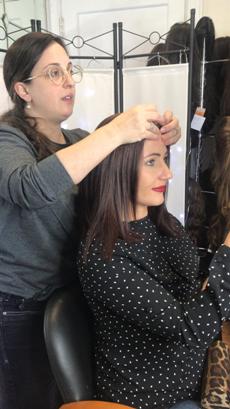When my reputation started growing, specifically on social media, the first thing I noticed was that more and more people started asking me advice, especially about how to go about buying a wig. Ethically, I have to be very careful about affecting someone else’s livelihood, or affecting your decision-making while you’re sitting in the sheitel macher’s chair, but I’ve assembled a general list of tips and tricks to help guide you through the buying process, whether you’re purchasing a wig in a one-on-one consultation with a stylist or at a sale.
#1 Check the Fit
Anyone who knows me knows that this is my pet peeve. If it doesn’t fit you, make sure it is a size too big, rather than too small. Not every professional knows how to do alterations on your wig, but one thing is universal—it’s both cheaper and better to make a wig smaller than it is to make it larger. This is not just because it’s easier, but also because making it larger is more liable to compromise the construction of its foundation. Extra seams, openings, and folds will make it much more possible and likely for the wig to fall apart over time—not to mention, also potentially uncomfortable.
Don’t just feel for how it wraps around your head in the direction that you would wear a headband. Also feel for how much space you have from front to back and side to side, across the top of your head, and around the back of your head. There are so many dimensions to the human head, and each head is different, so be extra safe and careful that it’s not too small.
#2 Color Selection
Sale wigs and lower quality hair may or may not be able to have their color altered. You can almost always make a wig darker, so you might be told at a sale that the wig can be colored. In this case, you still might only be able to make it darker, but not lighter. Also keep in mind that when you make a wig darker, even if it’s just at the roots, it’s more likely to fade in the sun and from washing over time than if you keep the color as it is from the factory. If you are making a wig darker, be clear about how much of the wig you want colored—whether it’s roots, long roots, lowlights, or the whole thing.
Making a wig lighter might be impossible. If the hair has already been colored at the factory, the dyes which they use are less likely to be able to be lightened. Sometimes they turn pink, green, or even shades of gray. If it’s unprocessed hair, you’ll be able to lighten it, but make sure to discuss it with a qualified colorist—and that you understand the processes of making something lighter—before you buy the wig. You might end up compromising the texture of your wig, and once you play with the color, you’ll be stuck with it no matter how it turns out. Also, depending how many shades you want to change, you might have more or less success. If you are lightening a wig (after you’ve been assured it is possible), be clear about how light or dark you want it, how much differentiation you want from darkest to lightest shade in the wig, how big or small you want the highlights to be, and how much of the wig you want colored.
#3 Pay Attention to Texture
Don’t buy a straight wig expecting it to hold a curl, and don’t buy a wavy wig expecting to be able to straighten it and keep it staying stick-straight in the humid summer months. You might have a harder time with this step when buying a wig at a one-day sale, but if you’re buying in a one-on-one consultation setting, you can usually ask for the wig to be washed and air-dried so that you can see it in its natural state. Even the straightest hair will dry with a small amount of soft wave to it, unless it has been chemically treated, in which case, you have to worry about the life expectancy of the wig, as any chemical treatment can compromise its longevity and long-term wearability.
When you look at the texture, pay attention to the softness of the wave. These soft waves do not mean that the hair is wavy, but the depth of the curves in these waves indicates just how long it might hold a set. Deeper curves mean more natural waves and curls, and the potential of your wash and set lasting longer from wash to wash. Softer curves mean straighter hair, less fluff and fuzz, and sleeker wear between washes.
#4 Length Check
This is the most obvious aspect of a wig to check, but sometimes it pays to reiterate the obvious points, just to make sure they’re clear. Obviously, if the wig isn’t long enough for what you want to do with it, you’re not going to buy it, but you have to double check that the style won’t change what you want to do with a wig that you do think is fitting.
First of all, if you’re buying a long wig to cut it short just because it’s on sale, realize that different textures of hair will behave dramatically differently when they are shorter or longer. Secondly, if you want to keep the length and just cut layers into it, try to confirm with a professional stylist that you’ll still be maintaining all the length that you see. Sometimes cutting layers around the face can remove some of the hair hanging near your face and the perception of length you see in the mirror, even though you didn’t touch the length in the back. This problem lies in a little industry issue we call “shoulder intrusion”, where your shoulders may prevent you from seeing the full length of the wig. If you have a good eye, you might be able to figure this out yourself, but if you’re not the one doing the actual cutting, sometimes it pays to get a second opinion about this before you take the plunge and buy it!
Good luck with your purchase!











